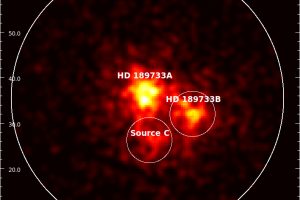The interaction between star and planet triggers more energetic flares. The study: “X-ray variability of HD 189733 across eight years of XMM-Newton observations” of I. Pillitteri (INAF – OAPA) recently appeared on A&A

The corona is the outermost part of the atmosphere in stars with intermediate and low mass. In this region, which is extended for several stellar radii, the plasma can reach temperatures of several million degrees, emitting mainly X-ray radiation. The coronal temperature varies over a range of several orders of magnitude as a function of several stellar parameters, such as age, rotation, mass and internal structure. In the solar corona, for instance, the mean plasma temperature is 1-2 million degrees. The coronal plasma reaches higher temperatures during flares, which are transient phenomena occurring in the corona, triggered by impulsive release of large amount of energy.
Stellar coronal activity can be affected by the presence of gaseous planets orbiting very close to their stars, which are called Hot Jupiters. These are giant planets which, for reasons which are currently under investigation, are orbiting at distances from their stars of a fraction of Astronomical Unit (AU, which is the mean Earth-Sun distance, equal to 150 million km), with orbital periods shorter than 10 days. Typical examples of these star-planet interactions, which have been confirmed in a handle of cases, are: tidal effects, influence on the stellar coronal activity, and evaporation of the planetary atmosphere with part of the evaporating gas accreting onto the star.
One of the best available targets to study star-planet interactions is HD 189733, a binary system composed by a K1 and a M4 star, only 63 light years away from us. The primary star (HD 189733 A) hosts a hot Jupiter (HD 189733 Ab) with a mass of 1.16 Jupiter masses, orbiting at a distance of 0.03 AU from HD 1899733 A and with an orbital period of 2.2 days. This system has been targeted by the X-rays satellite XMM-Newton during a long observation of more than 265 hours, which covered all the main orbital phases, including the primary transit (when the planet is transiting in front of the star along our line of sight) and the secondary transit (when the planet is transiting behind the star). The team of researchers led by the astronomer I. Pillitteri (INAF – Astronomical Observatory of Palermo) analyzed the XMM-Newton observations in order to study the relation between the stellar coronal activity and the orbital phase of the planet. In particular, while the mean coronal temperature (of about 4.6 million degrees) is not affected by the planet, the energy released during the coronal flares seems to change during the orbit of the planet. In fact, flares have been observed during 44% of the XMM-Newton observation, both during the secondary transit (51.5% of the observed flares) and the primary one (41.8%). By comparing the distribution of the energy released during the flares, the team has demonstrated that flares are on average more energetic during the secondary transit. This difference can be due to the magnetic connection existing between star and planet. As shown by magnetohydrodynamic simulations performed by a team of the Astronomical Observatory of Palermo (link), the configuration of the magnetic field connecting star and planet can be instable as a consequence of the interaction with the stellar wind, and occasionally it can meet the criteria necessary for triggering flares. This hypothesis is supported by the characterization of some of he observed flares adopting available models, which results in magnetic loops several stellar radii long. The study is described in the paper: “X-ray variability of HD 189733 across eight years of XMM-Newton observations“, recently appeared on Astronomy & Astrophysics, with the collaboration of the astronomers G. Micela, A. Maggio e S. Sciortino dell’INAF – Osservatorio Astronomico di Palermo and J. Lopez-Santiago of the Universidad Carlos III de Madrid.
The figure (click here to visualize the entire image) shows an XMM-Newton observation (with the instrument MOS1) of the HD 189733 system. Both stars of the binary system are clearly visible (during this observation a flare occurred in HD 189733 B) together with a third source (Source C) which is a background active galaxy (AGN). The large circle has a radius of 30 arcsec, while the small ones of 5 arcsec.
Mario Giuseppe Guarcello ( follow mguarce) ( youtube)
Follow the Astronomical Observatory of Palermo on Facebok
Subscribe the Youtube channel of the Astronomical Observatory of Palermo
